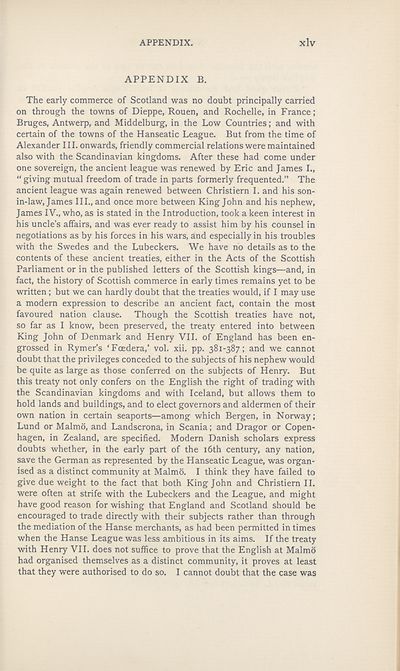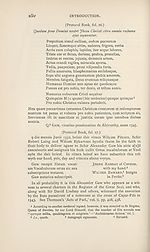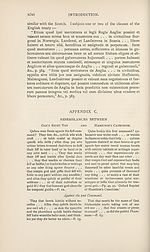Scottish Text Society publications > Old series > Richt vay to the Kingdome of Heuine
(51) Page xlv
Download files
Complete book:
Individual page:
Thumbnail gallery: Grid view | List view

APPENDIX.
xlv
APPENDIX B.
The early commerce of Scotland was no doubt principally carried
on through the towns of Dieppe, Rouen, and Rochelle, in France;
Bruges, Antwerp, and Middelburg, in the Low Countries; and with
certain of the towns of the Hanseatic League. But from the time of
Alexander III. onwards, friendly commercial relations were maintained
also with the Scandinavian kingdoms. After these had come under
one sovereign, the ancient league was renewed by Eric and James L,
“giving mutual freedom of trade in parts formerly frequented.” The
ancient league was again renewed between Christiern I. and his son-
in-law, James III., and once more between King John and his nephew,
James IV., who, as is stated in the Introduction, took a keen interest in
his uncle’s affairs, and was ever ready to assist him by his counsel in
negotiations as by his forces in his wars, and especially in his troubles
with the Swedes and the Lubeckers. We have no details as to the
contents of these ancient treaties, either in the Acts of the Scottish
Parliament or in the published letters of the Scottish kings—and, in
fact, the history of Scottish commerce in early times remains yet to be
written; but we can hardly doubt that the treaties would, if I may use
a modern expression to describe an ancient fact, contain the most
favoured nation clause. Though the Scottish treaties have not,
so far as I know, been preserved, the treaty entered into between
King John of Denmark and Henry VII. of England has been en¬
grossed in Rymer’s ‘Foedera,’ vol. xii. pp. 381-387; and we cannot
doubt that the privileges conceded to the subjects of his nephew would
be quite as large as those conferred on the subjects of Henry. But
this treaty not only confers on the English the right of trading with
the Scandinavian kingdoms and with Iceland, but allows them to
hold lands and buildings, and to elect governors and aldermen of their
own nation in certain seaports—among which Bergen, in Norway;
Lund or Malmo, and Landscrona, in Scania; and Dragor or Copen¬
hagen, in Zealand, are specified. Modern Danish scholars express
doubts whether, in the early part of the 16th century, any nation,
save the German as represented by the Hanseatic League, was organ¬
ised as a distinct community at Malmo. I think they have failed to
give due weight to the fact that both King John and Christiern II.
were often at strife with the Lubeckers and the League, and might
have good reason for wishing that England and Scotland should be
encouraged to trade directly with their subjects rather than through
the mediation of the Hanse merchants, as had been permitted in times
when the Hanse League was less ambitious in its aims. If the treaty
with Henry VII. does not suffice to prove that the English at Malmo
had organised themselves as a distinct community, it proves at least
that they were authorised to do so. I cannot doubt that the case was
xlv
APPENDIX B.
The early commerce of Scotland was no doubt principally carried
on through the towns of Dieppe, Rouen, and Rochelle, in France;
Bruges, Antwerp, and Middelburg, in the Low Countries; and with
certain of the towns of the Hanseatic League. But from the time of
Alexander III. onwards, friendly commercial relations were maintained
also with the Scandinavian kingdoms. After these had come under
one sovereign, the ancient league was renewed by Eric and James L,
“giving mutual freedom of trade in parts formerly frequented.” The
ancient league was again renewed between Christiern I. and his son-
in-law, James III., and once more between King John and his nephew,
James IV., who, as is stated in the Introduction, took a keen interest in
his uncle’s affairs, and was ever ready to assist him by his counsel in
negotiations as by his forces in his wars, and especially in his troubles
with the Swedes and the Lubeckers. We have no details as to the
contents of these ancient treaties, either in the Acts of the Scottish
Parliament or in the published letters of the Scottish kings—and, in
fact, the history of Scottish commerce in early times remains yet to be
written; but we can hardly doubt that the treaties would, if I may use
a modern expression to describe an ancient fact, contain the most
favoured nation clause. Though the Scottish treaties have not,
so far as I know, been preserved, the treaty entered into between
King John of Denmark and Henry VII. of England has been en¬
grossed in Rymer’s ‘Foedera,’ vol. xii. pp. 381-387; and we cannot
doubt that the privileges conceded to the subjects of his nephew would
be quite as large as those conferred on the subjects of Henry. But
this treaty not only confers on the English the right of trading with
the Scandinavian kingdoms and with Iceland, but allows them to
hold lands and buildings, and to elect governors and aldermen of their
own nation in certain seaports—among which Bergen, in Norway;
Lund or Malmo, and Landscrona, in Scania; and Dragor or Copen¬
hagen, in Zealand, are specified. Modern Danish scholars express
doubts whether, in the early part of the 16th century, any nation,
save the German as represented by the Hanseatic League, was organ¬
ised as a distinct community at Malmo. I think they have failed to
give due weight to the fact that both King John and Christiern II.
were often at strife with the Lubeckers and the League, and might
have good reason for wishing that England and Scotland should be
encouraged to trade directly with their subjects rather than through
the mediation of the Hanse merchants, as had been permitted in times
when the Hanse League was less ambitious in its aims. If the treaty
with Henry VII. does not suffice to prove that the English at Malmo
had organised themselves as a distinct community, it proves at least
that they were authorised to do so. I cannot doubt that the case was
Set display mode to: Large image | Zoom image | Transcription
Images and transcriptions on this page, including medium image downloads, may be used under the Creative Commons Attribution 4.0 International Licence unless otherwise stated. ![]()
| Publications by Scottish clubs > Scottish Text Society publications > Old series > Richt vay to the Kingdome of Heuine > (51) Page xlv |
|---|
| Permanent URL | https://digital.nls.uk/113770472 |
|---|
| Description | A collection of over 100 Scottish texts dating from around 1400 to 1700. Most titles are in Scots, and include editions of poetry, drama, and prose by major Scottish writers such as John Barbour, William Dunbar, Gavin Douglas, and George Buchanan. Edited by a key scholarly publisher of Scotland's literary history, and published from the late 19th century onwards by the Scottish Text Society. Available here are STS series 1-3. |
|---|

